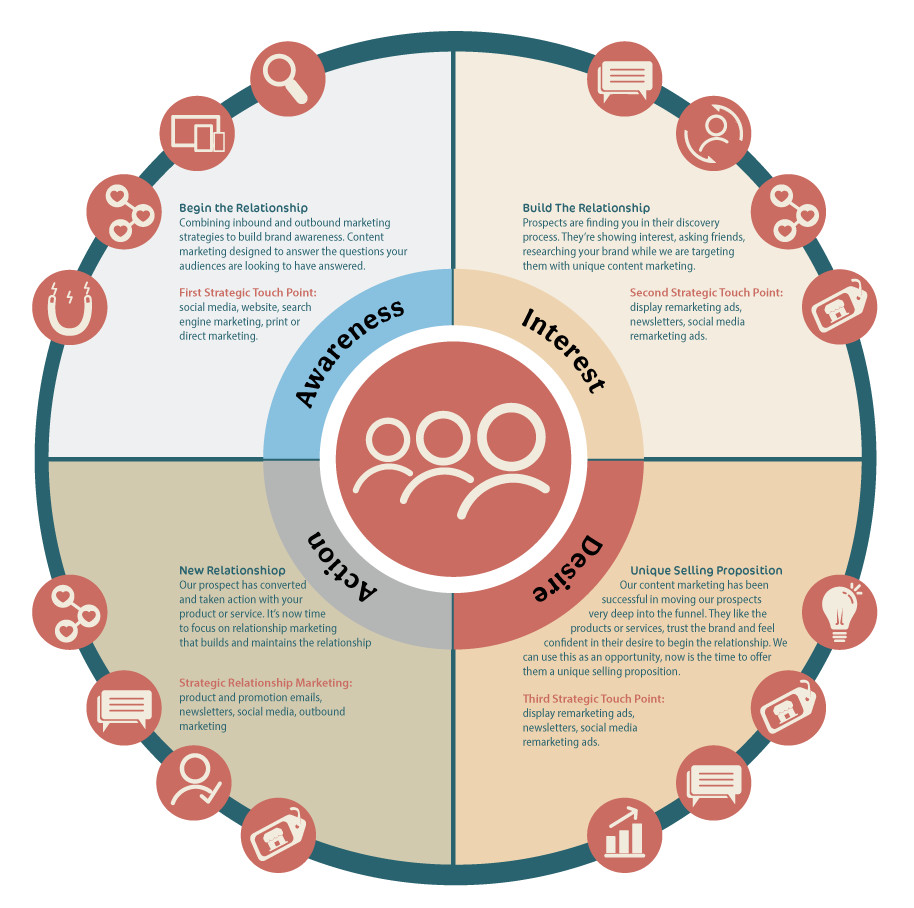What Is A Digital Marketing Funnel
What are digital marketing funnels?
They’re tailored strategies that apply to social media, digital ads or email marketing campaigns. Typically a well structured marketing funnel will find your digital advertising campaigns in sync, utilizing similar touch points for specific audience messaging.
Digital marketing funnels actually share the same conceptual foundation as outbound / print marketing, but vary in approach based on the platform used for your messaging. I typically describe funnels from the top view and with two approaches. Prospects believe it or now enter a funnel at various stages. The journey may begin through a search result, a website visit, a targeted display or social ad, e-blast and believe it or not… print advertising.
It’s all about the ability to understand the data, make the connections to patterns and apply a strategy for messaging. Making sure to capitalize on each opportunity by creating unique touch points to deliver tailored messaging and move them through the pinwheel to a conversion.
2 Models for 1 Funnel
The first model I’m going to cover is AIDA (Awareness, Interest, Desire, Action), the most well known marketing model used for decades. AIDA is the foundation to all marketing campaigns, whether you know you’re using it or not. AIDA helps us to define the mediums, messaging, creative and overall strategy that applies to not just a digital marketing funnel, but marketing strategies as a whole. Below is an example of an overhead view of the AIDA model, this model puts the targeted audience in the center opposed to the traditional linear view.
The second model is the PINwheel (Prospect, Insight, New Relationship) which defines strategic touch points. These touch points provide unique messaging that offers insight into your brand. As prospects continue their discovery process in their journey to becoming a new relationship. The PINwheel model is more granular and applied strategically to campaigns like social media and display advertising.
The strategy development process relies on AIDA as the foundation and combines data research with strong content marketing. The PINwheel uses audience targeted, custom audience remarketing, search, custom events and more to create the flow. Applying a form of conditional logic, for example:
- if a prospect performed this action, add them to this audience and send them this message
- If a prospect performed this action but not this action, sent them this message
- if a prospect is in this audience and not this audience, send them this message
- if a prospect performed this action, and this action and is in this audience, stop serving them ads
As we can see, combining these two models outlines a clear path for strategic messaging and the building blocks for successful marketing campaigns. Enabling the ability for stronger reporting, more successful measurables all while preventing throwing good money after bad.
How does this funnel thing work exactly?
Here’s a little example:
Our strategy has put a focus on making sure we have strong organic, targeted and search campaigns for brand awareness. A Prospect is researching a product or service related to your brand. They discover you in a search query and click to visit your website. The prospect is now in your funnel and we have messaging in place to nurture the relationship.
As a prospect continues their discovery process on your brand. Our strategy begins using content marketing to provide insight, serving ads based on the type of engagement they have with your brand. The touch points are not limited in this process, each is designed to move them one step closer to a new relationship. This touch point is a social media ad offering them to learn more, they click through and they sign up for a newsletter. They receive a newsletter with a highlighted piece of content and click through to your website to learn more. The prospect is deep into the funnel at this point. The next touch point is designed to show them an ad as they surf the internet, offering a unique selling proposition.
At this point, by identifying how we want to communicate with prospects we’re able to make data driven decisions that maximize budgets. The unique selling proposition offered the deal they were looking for. The prospect trusts your brand, has confidence in your product or service and they’re ready to convert to becoming a new relationship.
We don’t stop here, from this point on we use content marketing that builds on the relationship. Ensuring our new relationships that we care about them and value their commitment to our brand.
What’s Next?
As with any successful campaign, the process begins with data and research. We need to understand audiences, habits, interests as well as identify new opportunities.
After the data research, it’s time to shift focus on patterns of the data and how we can apply what we learned to create the touch points and best mediums to use.
At this point the strategy is merged with design to develop engaging messaging and creative content, intended to communicate a balance of who you are while answering the questions your audiences are looking for answers to.
Why do you need a funnel?
The question is if you’re spending money, why wouldn’t you want a digital marketing funnel? Analytics and insights continue to provide information about your audiences giving us the opportunity to make data driven decisions and maximize ROI.
Identifying the components of a successful digital marketing funnel and what are the best approaches to creating engaging content to move customers through the funnel.

